With this tutorial, we will be showing you the process of installing the UniFi Controller on a Raspberry Pi
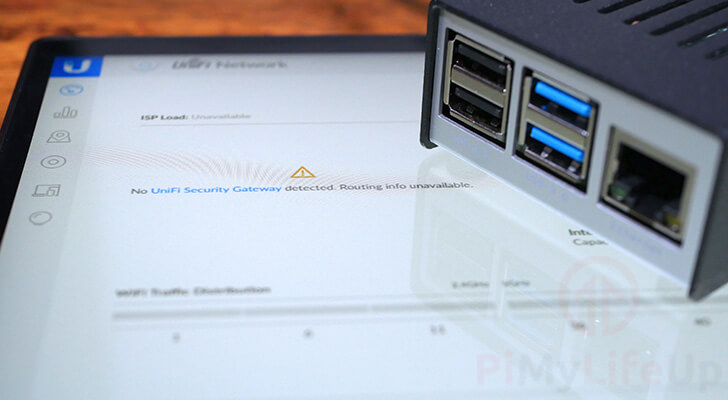
UniFi is a range of network devices created by Ubiquiti. These devices range from Wi-Fi access points to security gateways and switches.
Setting up the UniFi software on a Raspberry Pi is a fairly straightforward process as it just relies on the multi-platform Java runtime to run.
Using the UniFi network controller, you can manage all the UniFi devices that are a part of your network. You will also be able to use this dashboard to see the statistics of your UniFi network.
Please note that before proceeding you will need to be running a 64-bit version of Raspberry Pi OS for this tutorial to work. Recent changes to UniFi have broken support for 32-bit operating systems.
Equipment List
Below is a list of the equipment that you will need to set up the Unifi Network Controller software on your Raspberry Pi
Recommended
Optional
This tutorial on setting up the UniFi Network Controller was tested on a Raspberry Pi 5 running the latest version of Raspberry Pi OS Bookworm 64-bit.
Video
The video we have embedded below will walk you through all of the steps needed to set up the UniFi network server on your Raspberry Pi. If you prefer to go at your own pace, be sure to follow our written instructions below instead.
Preparing your Raspberry Pi for the UniFi Controller
In this section, we will prepare the operating system to run the UniFi software. These steps mainly revolve around getting the database server UniFi requires installed on your Raspberry Pi.
Getting Ready
1. The first thing you should do is ensure that your Raspberry Pi is running up to date packages.
To update all packages, you will be required to run the following command.
sudo apt update
sudo apt upgradeCopyAdding Entropy using rng-tools
2. To improve the startup speed of the UniFi controller software on our Raspberry Pi, we need to install rng-tools.
We will utilize this package to ensure the Raspberry Pi has enough entropy for the random number generation that the UniFi software uses.
sudo apt install rng-toolsCopy3. We now need to make a slight change to the rng-tools configuration.
Begin editing the config file by running the following command.
sudo nano /etc/default/rng-tools-debianCopy4. Within this file, find and uncomment the following line.
Find
#HRNGDEVICE=/dev/hwrngCopyReplace With
HRNGDEVICE=/dev/hwrngCopyBy uncommenting this line, we are adding to the amount of entropy (The amount of randomness) that the system has available.
The Raspberry Pi features an integrated random number generator that we can utilize to increase the entropy pool.
5. Once you have made the change, save the file by pressing CTRL + X, then Y, followed by ENTER.
6. Finally, restart the rng-tools service by running the command below.
sudo systemctl restart rng-toolsCopyOnce the service has finished restarting, it should now be safe to proceed to the next section of this guide.
Installing LibSSL1.1
7. Due to the version of MongoDB that we will be utilizing, we will need to install LibSSL 1.1 to our Raspberry Pi.
You can install this release of LibSSL by using the following command in the terminal.
sudo apt install libssl1.1CopyInstalling MongoDB to your Raspberry Pi for the UniFi Controller
8. To use the UniFi Controller on your Raspberry Pi, we will need to install MongoDB.
This is the database server that UniFi uses to store all of its data. As we can’t rely on the package repository, we will need to follow some additional steps.
For this first step, we will download MongoDB 4.4.18 to our Pi. We are installing 4.4 as this is currently the only supported release for the UniFi Controller that is compatible with the Raspberry Pi.
wget https://repo.mongodb.org/apt/ubuntu/dists/focal/mongodb-org/4.4/multiverse/binary-arm64/mongodb-org-server_4.4.18_arm64.deb -O mongodb.debCopy9. Once the package is downloaded, install it by using the following command within the terminal.
sudo dpkg -i mongodb.debCopy10. Now that we have installed the MongoDB server, set it to start when your Raspberry Pi boots using the command below.
sudo systemctl enable mongodCopy11. Finally, start MongoDB by running the command shown below in the terminal.
This will start the server immediately, so we won’t have to wait till our device restarts.
sudo systemctl start mongodCopyInstalling the UniFi Controller to the Raspberry Pi
1. Our first task is to add the UniFi repository to our sources list.
We can achieve this by running the command below.
echo 'deb [arch=amd64 signed-by=/usr/share/keyrings/ubiquiti-archive-keyring.gpg] https://www.ui.com/downloads/unifi/debian stable ubiquiti' | sudo tee /etc/apt/sources.list.d/100-ubnt-unifi.list >/dev/nullCopyYou might notice that we are using “amd64” and not “arm64” or “armhf“. This is due to Ubiquiti not having their repository set up to mark “arm64” as compatible. However, it doesn’t hugely matter as, at the moment, it will still download files compatible with our Raspberry Pi.
2. We now need to add the repositories GPG key by using the following command.
curl https://dl.ui.com/unifi/unifi-repo.gpg | sudo tee /usr/share/keyrings/ubiquiti-archive-keyring.gpg >/dev/nullCopyThe GPG key is what helps tell the package manager it is downloading the correct package.
3. As we made changes to the repositories, we need to now update the package list by running the command below.
sudo apt updateCopy4. Now finally, we can install version 17 of the OpenJDK runtime as well as the Unifi Controller software itself to our Raspberry Pi by running the following command.
sudo apt install openjdk-17-jre-headless unifiCopyInstalling UniFi through this method will automatically set up a service. This service will automatically start the UniFi software at boot.
Additionally, we are installing version 17 of the Java runtime environment as it is currently the only version supported by the UniFi controller.
First Boot of the UniFi Controller on your Raspberry Pi
In this section, we are going to walk you through the initial configuration steps of the UniFi software.
1. First, retrieve the local IP address for your Raspberry Pi.
If you have terminal access to your Pi, you can use the following command.
hostname -ICopy2. With your Raspberry Pi’s IP address handy, go to the following web address in your favorite web browser.
Ensure that you replace “<IPADDRES>” with the IP of your Raspberry Pi.
https://<IPADDRESS>:8443If you run into a certificate error, it is safe to ignore it as we know what device we are connecting to.
3. The first step requires you to give a name for your Raspberry Pi powered UniFi controller (1.).
You are also required to agree to the end-user license agreement and terms of service from UniFi, once you have read through them, click the checkbox (2.).
Once all done, click the “Next” button (3.) to proceed.
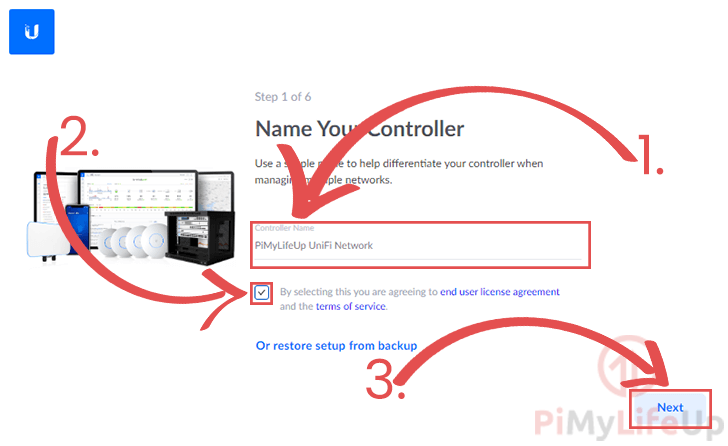
4. Next, you will need to sign in to your Ubiquiti account (1.).
If you don’t already have an account, you can register at the Ubiquiti website.
Once you have entered your login details, proceed by clicking the “Next” button.
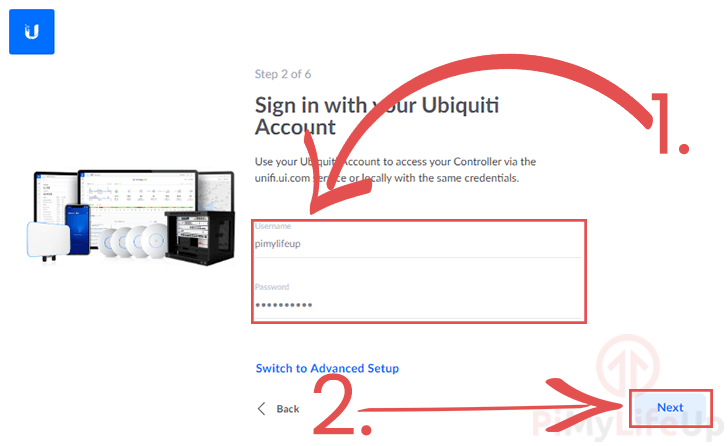
5. Tweak the settings on this page that best suits your needs.
Once configured, click the “Next” button.
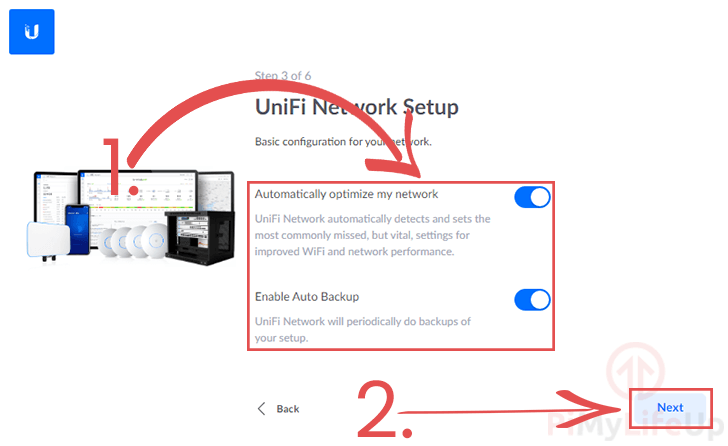
6. Use this screen to connect your Pi UniFi Network controller to the devices on your network.
To proceed, click the “Next” button.
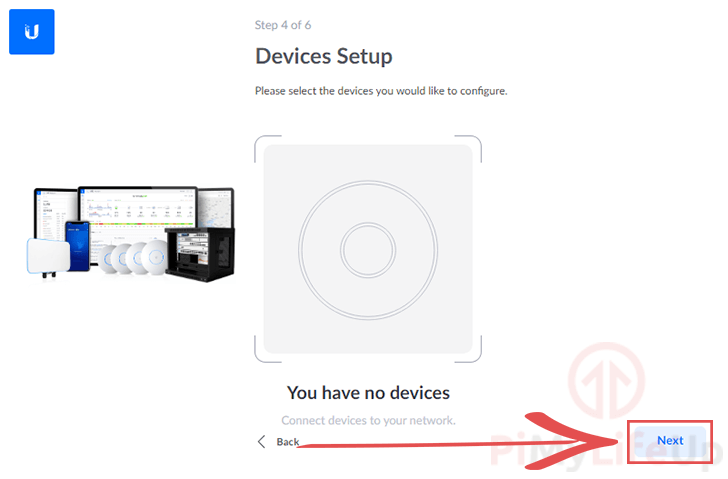
7. Now give your new Wi-Fi network a name and a password.
Once you have configured your WiFi details (1.), click the “Next” button to proceed (2.).
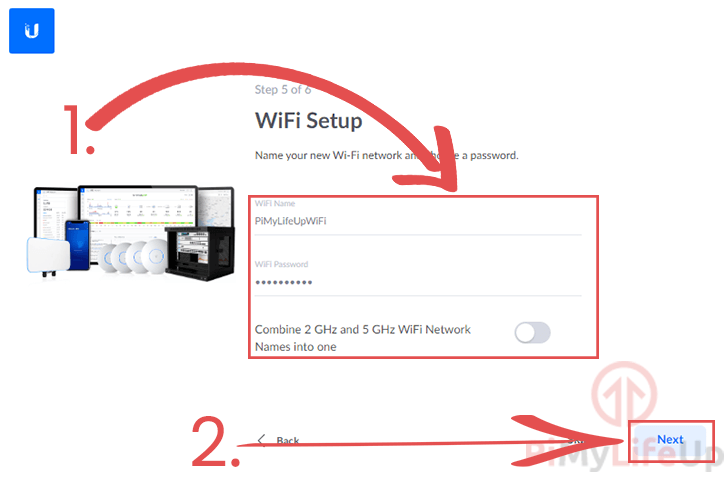
8. This final screen will get you to review all your settings.
You will also be able to use this screen to set both the country and timezone (1.). Make sure you set these before continuing.
Once you have verified everything is correct, you can now click the “Finish” button (2.) to finish the setup process.
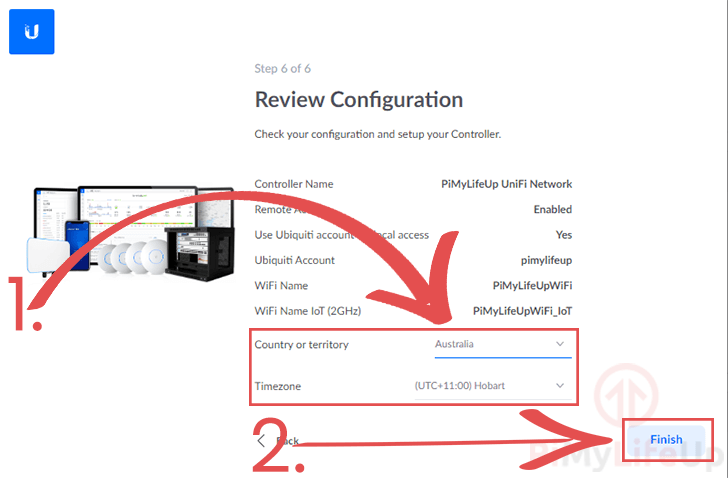
7. At this point, you should now have successfully set up the UniFi network controller on your Raspberry Pi.
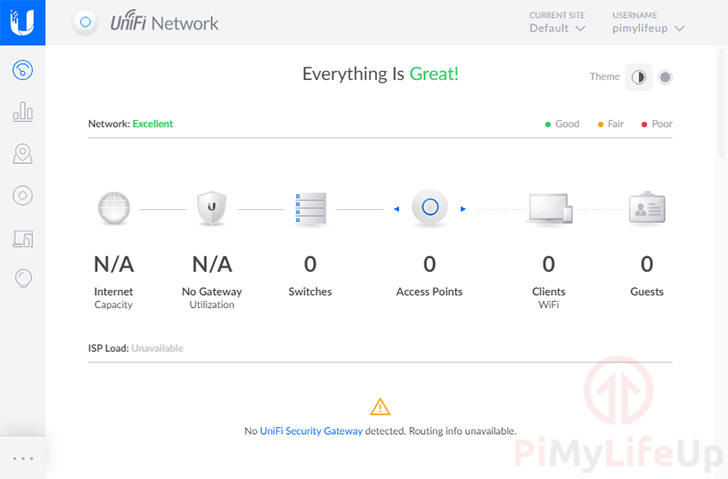
Conclusion
Hopefully, at this point in the tutorial, you will now have the UniFi controller installed and running on your Raspberry Pi.
The Pi is a great base for your network controller as it can run 24/7 with little power.
If you have run into any issues setting up the UniFi software, feel free to comment below.
Check out our many other Raspberry Pi tutorials to learn more about this versatile system.

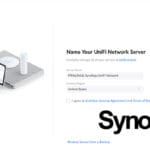
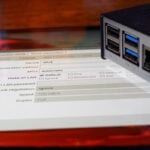
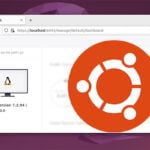

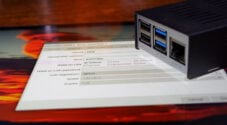
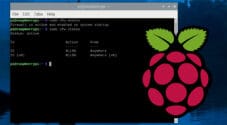
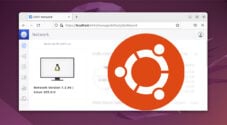


I see that unifi is now at version 8.1, and seems a big update, now supports mongodb to v7.
Is it a simple update from v8 to v8.1 on the rpi as installed by this guide?
Hi Edward,
The problem with newer versions of MongoDB is that they explicitly claim they do not support the Raspberry Pi and the version of ARM it uses in newer releases of MongoDB. On that note, I have updated the tutorial to at least use MongoDB 4.4 (The last one with support for the ARM processor the Pi uses).
If you are using an older version of this tutorial, you should be fine continuing to run MongoDB 3.6 as that is still supported as of the latest release. It should be safe to update to the latest release by using “sudo apt update && sudo apt upgrade”. But as always, make a back up before you update.
Kind regards,
Emmet
Hi Emmet,
Thank you for the great advice. I updated as you suggested and no issues going from v8 to v8.1 Just updated unifi and mongodb unchanged.
Regards
Edward
I am unable to install mongodb on my Pi4 running Raspbian 11 Bullseye. I have followed the instructions listed here and see the following error.
sudo dpkg -i libssl1.0.deb
dpkg: error processing archive libssl1.0.deb (–install):
package architecture (arm64) does not match system (armhf)
Errors were encountered while processing:
libssl1.0.deb
Hi Wedge,
It appears that you are running a 32-bit version of Raspberry Pi OS.
You must be running a 64-bit version for this tutorial to work.
Kind regards,
Emmet
Unfortunately I could not install today. Mongodb returns “mongod.service: Failed with result ‘signal’.”
Tried mongodb 3.6 with no success.
My Pi4 is 2mb, Bullseye OS 11 (64 bit). Any advice or tip, please ?
Use the MongoDB version 4.4.18 instead of the newer version. Worked for me.
Posting just to say “Thank you!”. I am a linux noob but know my way around. Your tutorial was straighforward and to the point. I do want to point out when trying to download the java and mongo files, it seems to get stuck on the IPv6 repos it attempts first. Once they attempt an IPv4 repo, files downloaded promptly. Not sure if others have experienced this but if so, please be patient!
Hi Everyone,
I’ve bee trying for the past two weeks to get my Rasberry Pi 3b+ to work following this guide.
A fresh approach today worked perfectly.
Installed Bookworm 64 Bit Lite – No desktop.
Followed the guide – System working perfectly with no problems.
Its not sluggish – restored my current settings from my PC to the PI and current version of the Unifi Controller Network 8.0.26.
I was going to sell all my equipment today for a New Tplink Omada system.
Give it another try if you’ve had problems.
Thank you for the guide.
Hi i not can download have a error.
Hi Basti,
It looks like your internet connection is having issues connecting to Ubiquiti’s repository. I quickly tested this locally and am not facing the same connection error.
A couple of things you could try. First is to try using a different DNS provider such as Cloudflare (1.1.1.1) or Google DNS.
Alternatively, if that still doesn’t work you could attempt to use a VPN.
Kind regards,
Emmet
Unfortunately it doesn’t work either 🙁 At first I thought it could also be due to PIHole, but I also identified it without success
Just checking in – I installed on Bookworm using a brand new 64bit install, and all the steps in this guide worked flawlessly. I used the “lite” version since I am running the Pi headless and don’t need a desktop. Thanks for a straightforward guide.
Worked for me. Thanks a lot.
First off, thank you for putting together and maintaining this guide. It is fantastic.
I am trying to update Unifi, but it thinks it is already at the latest version. Looking at the list of packages, I suspect I tangled myself up somehow as the package has the version listed. I can only guess that I made it 7.4 specific somehow. Any feedback would be greatly appreciated.
Hi Mike,
Sorry to see that you are having issues updating Unifi.
My thought immediately goes to you potentially completing this tutorial when we had a different workaround in place. This workaround was pinning UniFi to the older release repository.
You should be able to just update to the new line where we tell the repository to grab the X64 version of the repository (Unifi is written in Java, so for now we can continue to run the software regardless of what their repo claims.
Just run the following command.
And then re-run a “sudo apt update” and “sudo apt upgrade”.
Please let me know if this resolves the issue you are running into.
Kind regards,
Emmet
Hi there.
Do I need to run a specific version of raspbian, to get this to work?
I’m running Bullseye, and I get a lot of errors, while trying to follow your tutorial.
pi@ubntcontroller:~ $ sudo dpkg -i libssl1.0.deb
dpkg: error processing archive libssl1.0.deb (–install):
package architecture (arm64) does not match system (armhf)
Errors were encountered while processing:
libssl1.0.deb
pi@ubntcontroller:~ $ sudo dpkg -i mongodb.deb
dpkg: error processing archive mongodb.deb (–install):
package architecture (arm64) does not match system (armhf)
Errors were encountered while processing:
mongodb.deb
Hope to hear from you.
Hi Michael,
As mentioned at the start of the tutorial, you must be running a 64-bit (ARM64) version of Raspberry Pi OS for this tutorial to work.
You are currently running a 32-bit (armhf) version.
Kind Regards,
Emmet
Thank you very much for this
I am a farmer and an idiot at this! Every step goes great, cannot resolve ip address in browser, browser instead searches web for hits (step 2 of “first boot”).
Help please and use small words.
Much appreciated.
Hi Dupie,
Sorry to hear that you are running into issues with connecting to the UniFi controller.
First, ensure you are connecting to your Pi’s IP address when typing in the URL. For example, our IP for our Pi is
192.168.0.134so we would use the URL “https://192.168.0.134:8443“.If that doesn’t work, try checking the status of the “
unifi” service by using the following command.If everything is working properly, you should see something like “
Active: active (running)“.Kind Regards,
Emmet
Thank you for the speedy reply Emmet. This solved my problem, cause I did not remove the [..] brackets when I entered the IP address. I laughed at myself too.
Hi.
Thank you for this easy-to-follow-guide.
Big up!
The install process fails for me on step 8, with the following error
pi@raspiserv:~ $ sudo dpkg -i libssl1.0.deb
dpkg: error processing archive libssl1.0.deb (–install):
package architecture (arm64) does not match system (armhf)
Errors were encountered while processing:
libssl1.0.deb
Raspi 3B; running Bullseye
Hi Veejaymat,
As mentioned at the start of the tutorial, you must be running a 64-bit version of Raspberry Pi OS. You are using an “
armhf” system which is 32-bit.Kind regards,
Emmet
Very weird… I have a 64bit version installed – yet when I run sudo apt update it gives me the following message:
When I check if I am running 64 bit – it shows this:
This is my version:
THANKS SO MUCH – YOU’RE THE BEST!
Hi Jason,
Sorry to hear that you are having issues.
If you ran this tutorial previously, you will need to update the source file. We have to force the arch to “amd64” to get it to download newer releases from the repository.
You should hopefully be able to fix this by using the following command.
Please let me know if this resolves the issue for you.
Kind Regards,
Emmet
You’re an absolute boss! Thanks so much for this. After using that command I could run the usual sudo apt update / upgrade route and I updated from Network 7.4.162 to Network 8.0.7.
Thanks a lot!
I’ve used this method in the past for setting up a PI 3 to run UniFi controller. I’ve just tried to reconfigure on one of my PI s (corrupt memory card) and this method doesn’t seem to work for me any more, I get to the 88% when installing.
Is there a work-around to perhaps use an earlier version of the setup to get this to run?
Hi Dave,
The main thing I would recommend is trying Raspberry Pi OS Bullseye. For some reason Bookworm seems to be causing some weird issues, I’ve managed to successfully install it but others are still reporting issues.
Kind Regards,
Emmet
Anyone got it works on raspberry 3B 1G ram?
I got it to the step:
sudo apt install openjdk-17-jre-headless unifi
Stucked at 88% and the whole system freeze
Task manager shows 774MB of 908MB used, not sure if thats the issue?
Hi Eric,
While you should still be able to install OpenJDK 17, you will definitely run into issues if you did manage to install UniFi Controller. They recommend a minimum of 2GB of RAM.
EDIT: It appears there might be something going on weird with Bookworm on UniFi. Try using Buster in the mean time.EDIT2: Testing the tutorial again on a clean installation of Raspberry Pi OS 64-bit Bookworm, everything does seem to be working. Installation seems to take a bit longer than I remember it, but it does work.
I tested this on a Raspberry Pi 400 so that has 4GB of RAM.
Kind Regards,
Emmet
Hi Eric,
I had also problems at the same step.
I have a raspberry Pi 4. I had the problems with the newest OS.
With Raspberry Pi OS Bullseye 64-bit It runs.
Hi Volker,
I have successfully installed Unifi on to Raspberry Pi OS Bookworm 64-bit. So I’m not completely sure what is going wrong here.
The first time I tried with a non-clean system everything broke and it refused to install. But a clean install worked fine.
If someone is having issues with it getting stuck during setup, could you see if it has attempted to start up the UniFi service, and if there is anything in the logs if it does give a response.
You can check the status of the Unifi servce by running the following command.
Kind Regards,
Emmet
Thanks for the great tutorial.
Installed it on a Raspberry Pi 5, and it runs super smooth!
This updated guide (4th Oct 2023) is superb! I followed the steps on the latest version of Raspberry Pi OS (Bookworm) on my RPi 4B, everything runs like clockwork.
One thing to note from my experience and already reminded at the top of the article is to use only the 64 bit version of the OS. Otherwise you will get an libc error when trying to install LibSSL 1.0.
Hello from Singapore and thank you Emmet, I hope you will continue to keep this article updated. It helps many folks round the globe.
Thanks a lot, installation went smoothly with 64bit OS.
Thank you so much! It just worked, straight up first time!! Much appreciated.
Thx Emmet
Updated to 7.5 without issue
Much appreciated
Thank you! From the image, it looks like firmware 7.5 is being installed now? I used this a few months back and it’s been flawless but at the time 7.4 was the latest firmware. Could you please provide update instructions?
Hi Bartwick,
As long as you are running a 64-bit operating system, you should be able to follow the first few steps under the “
Installing the UniFi Controller to the Raspberry Pi” section.At step 4, you will want to run “
sudo apt install openjdp-17-jre-headless“, and then after that run “sudo apt upgrade -y“.Hopefully that should update your safely from Unifi 7.4 to 7.5. Just ensure you make a backup before following these steps.
Cheers,
Emmet
Great job!
Thank you
Thanks Emmet! Followed step-by-step and everything worked fine.